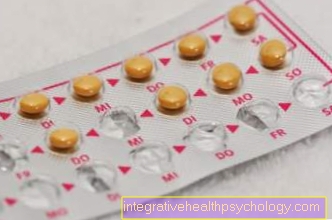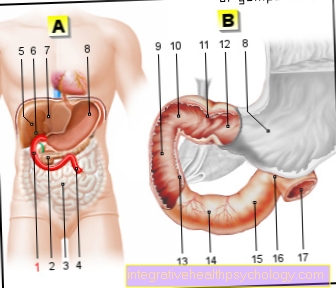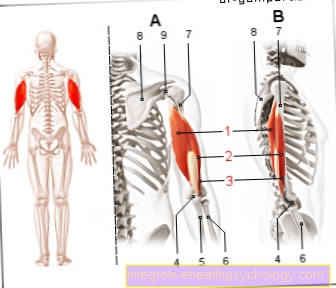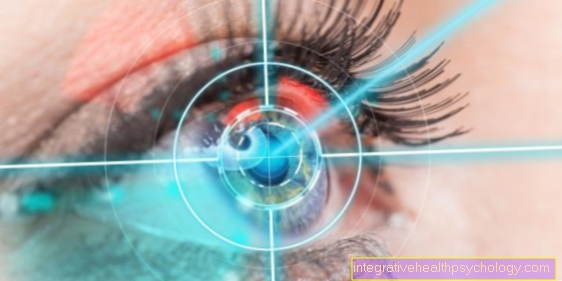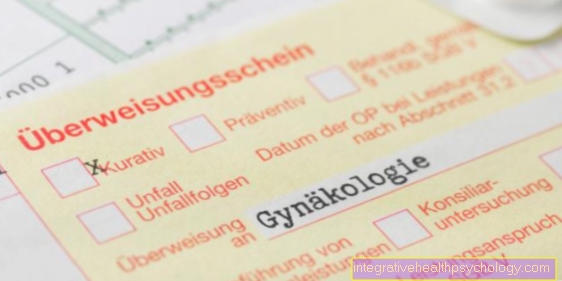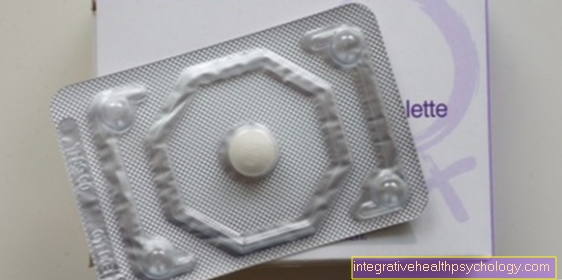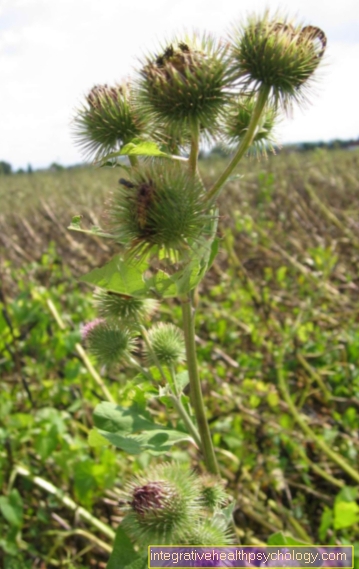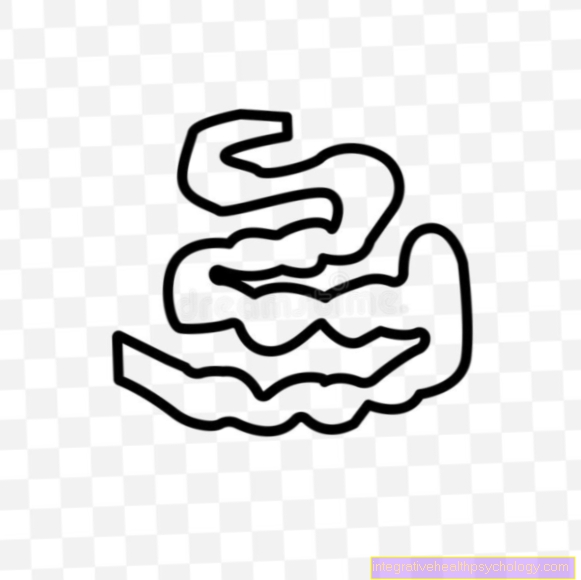Migraine attack
Definition - What is a migraine attack?
A migraine attack describes the acute occurrence of symptoms of the migraine disease and is often referred to as a migraine attack. The attack is often preceded by what is known as an aura, which consists of certain pre-emptive symptoms, such as flashes of light in front of the eyes. During the attack itself, people suffer from severe pulsating or pounding headaches. During the migraine attack, other symptoms such as vomiting, diarrhea, chills or neck pain occur again and again. Accordingly, the therapy in the acute phase typically consists of aspirin and MCP (metoclopramide) against nausea.

causes
When a person suffers from migraines, migraine attacks occur again and again. These are usually caused by certain triggers. Classically, this includes excessive stress. E.g. Students with migraines often have migraine attacks when an important exam is due. But other triggers, such as the consumption of red wine or chocolate, certain medications, a sudden change in the weather or too much sunlight can trigger a migraine attack. In women, migraine attacks are also occasionally associated with their periods. Accordingly, they should be avoided if they can be related to the seizures.
Read more on this topic at: Causes of headaches and how to differentiate premenstrual syndrome from pregnancy
diagnosis
If a migraine attack occurs for the first time in an as yet unknown migraine attack, the diagnosis is usually made afterwards as soon as the person concerned sees a doctor. Crucial indications of a migraine attack can be obtained primarily from the anamnesis, i.e. the doctor-patient conversation. A headache diary can be very useful to record the migraine attacks more precisely and to identify possible triggers. People who have suffered from migraines for years usually recognize a migraine attack themselves relatively quickly, as they usually proceed in a relatively similar manner and the symptoms are often similar.
Read more on this topic at: Headache diary
How can you tell the difference between a migraine attack and a stroke?
In most cases, a migraine attack can be easily distinguished from a stroke. Many sufferers have what is known as an aura before a migraine attack, i.e. certain symptoms, such as seeing flashes of light or a tingling sensation in the arm. The migraine attack itself leads to severe pulsating or boring pain, which is often accompanied by diarrhea, vomiting, or neck pain. After the attack subsides, there are usually no symptoms.
With a stroke, however, a severe headache and the phenomenon of the aura are rather untypical. There are also so-called neurological failures, for example problems speaking and paralysis of the face or an entire half of the body. Depending on the extent and time of diagnosis and therapy, these may persist for a longer period.
Read more on this topic at:
- migraine
- Signs of a stroke
- Transient ischemic attack
I recognize a migraine attack by these symptoms
A migraine attack usually has quite characteristic symptoms, which can vary in severity from those affected. Very often, before the actual attack begins, what is known as an aura, i.e. symptoms that are considered to be harbingers of the attack. This includes seeing lightning bolts or circles, and more rarely a tingling sensation or numbness in different parts of the body, dizziness or hearing loss.
Please also read: Poor falls asleep
The actual attack is characterized by often very severe headaches. These are mostly described as pulsating or boring and are typically located in one half of the head. The location of the headache can also change in the course of the attack. It is also typical that the pain is aggravated by any physical activity, so that those affected usually just lie in bed and wait until the migraine attack subsides.
Often accompanied by hypersensitivity to light and noise, as well as neck pain. Disturbances of the digestive tract with nausea, vomiting and diarrhea are also typical. Those affected can also freeze and often feel no appetite during or even after the attack. If left untreated, a migraine attack can last between 4 hours and 3 days.
Read more on this topic at:
- How do I recognize a migraine?
- Pain in the temple
- Headache with nausea
- Dizziness and headache
Treatment / therapy
The treatment of a migraine attack consists on the one hand in the acute relief of pain and on the other in the reduction of the accompanying symptoms.
Read more on this topic at:
- Therapy for migraines
- Homeopathy for migraines
Normal painkillers from the group of NSAIDs (non-steroidal anti-rheumatics) are often sufficient for the pain. These include the typically used drugs aspirin, ibuprofen and paracetamol. These should also be dosed in a sufficiently high dose when used, as a study has shown that the dose is often too low to be effective. For example, 1g of aspirin and paracetamol can be taken, and ibuprofen between 200 and 600mg.
Read more on this topic at:
- Painkiller
- Ibuprofen
- aspirin
If these drugs do not provide adequate pain relief, stronger pain relievers can be used. These include the triptans, some of which are now also available without a prescription. They are usually well tolerated and work approx. 30 minutes after ingestion.
Read more on this topic at: Triptans
In addition, there are drugs to counteract nausea or vomiting, as this is one of the most common and most unpleasant accompanying symptoms of a migraine attack. Medicines such as metoclopramide (also called MCP), domperidone or Vomex, for example, come into question here.
Read more on this topic at:
- Nausea medication
- Metoclopramide
- Vomex
How can I prevent a migraine attack?
In order to be able to prevent a migraine attack, an attempt should first be made to identify the trigger factors that may trigger it. To make this easier, keeping a migraine diary can be very helpful. Here it can be documented exactly when and under what circumstances a migraine attack occurred. If triggers can be identified as such, an attempt should be made to avoid them or to reduce their intensity, for example to reduce the consumption of red wine. Smoking cigarettes often promotes the development of a migraine attack and should therefore be considered as a possible trigger.
There are various medications that can generally be helpful as prophylaxis against migraine disease. These include, for example, beta blockers and flunarizine, but also valproate and topiramate. This should be discussed with the attending physician accordingly. In addition, acupuncture, sport, relaxation exercises and saunas can prevent migraine attacks. In some clinics, so-called headache seminars are offered, in which one can learn how to deal with a migraine attack correctly.
Read more on this topic at: Beta blockers for migraines
Duration
The duration of a migraine attack can vary greatly among those affected. Usually the minimum duration of an attack is around 4 hours. For some, however, the migraine attack can last up to 72 hours, i.e. a whole three days, if left untreated, during which those affected are barely able to go about their everyday life. It is therefore very important to recognize a migraine attack as such as soon as possible. This means that appropriate medication can be taken at an early stage, which can shorten the duration of the migraine attack.
forecast
The prognosis of a migraine attack is usually very good. If treated early, the attack usually lasts several hours and then subsides completely. Therefore, if the affected person notices that the medication they are taking is not working effectively, they should see a doctor to discuss the use of other medications. If the migraine disease itself is well controlled and certain preventive measures are taken, such as regular exercise, the prognosis for migraine attacks is also good.

